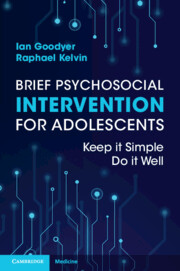Book contents
- Brief Psychosocial Intervention for Adolescents
- Brief Psychosocial Intervention for Adolescents
- Copyright page
- Contents
- Acknowledgements
- 1 Adolescence and the Psychotherapies
- 2 Evidence-Based Psychotherapy
- 3 Evolving the BPI Method
- 4 The Evidence Base for BPI
- 5 Practice Framework and Clinical Principles
- 6 Clinical Styles and Therapy Tools
- 7 BPI in Clinical Practice: Part One
- 8 BPI in Clinical Practice: Part Two
- 9 Top Tips for Best Practice
- Index
- References
8 - BPI in Clinical Practice: Part Two
Published online by Cambridge University Press: 16 March 2023
- Brief Psychosocial Intervention for Adolescents
- Brief Psychosocial Intervention for Adolescents
- Copyright page
- Contents
- Acknowledgements
- 1 Adolescence and the Psychotherapies
- 2 Evidence-Based Psychotherapy
- 3 Evolving the BPI Method
- 4 The Evidence Base for BPI
- 5 Practice Framework and Clinical Principles
- 6 Clinical Styles and Therapy Tools
- 7 BPI in Clinical Practice: Part One
- 8 BPI in Clinical Practice: Part Two
- 9 Top Tips for Best Practice
- Index
- References
Summary
We want to emphasise the importance of psychoeducation (PE) as an active intervention in clinical BPI practice. As noted already, PE was originally considered as a passive aid to medical treatments rather than an active therapeutic agent. For example, it is highly likely that PE enhances adherence and collaborative working in any intervention through explaining the implications of treatment to the patient. This is undoubtedly a useful mediating process but in BPI practice we want the therapist to utilise PE from the perspective that it acts as a therapeutic change element of treatment. For BPI practice, PE is the conversational delivery vehicle for information about how to understand mental states, engage in adaptive activities and habilitate and use new understandings and strategies to promote well-being and resilience in the face of future adversities. Whilst the focus is directly on the adolescent, such PE can also be delivered to important others such as family, carers and teachers, with the consent of the YP.
- Type
- Chapter
- Information
- Brief Psychosocial Intervention for AdolescentsKeep it Simple; Do it Well, pp. 85 - 101Publisher: Cambridge University PressPrint publication year: 2023



